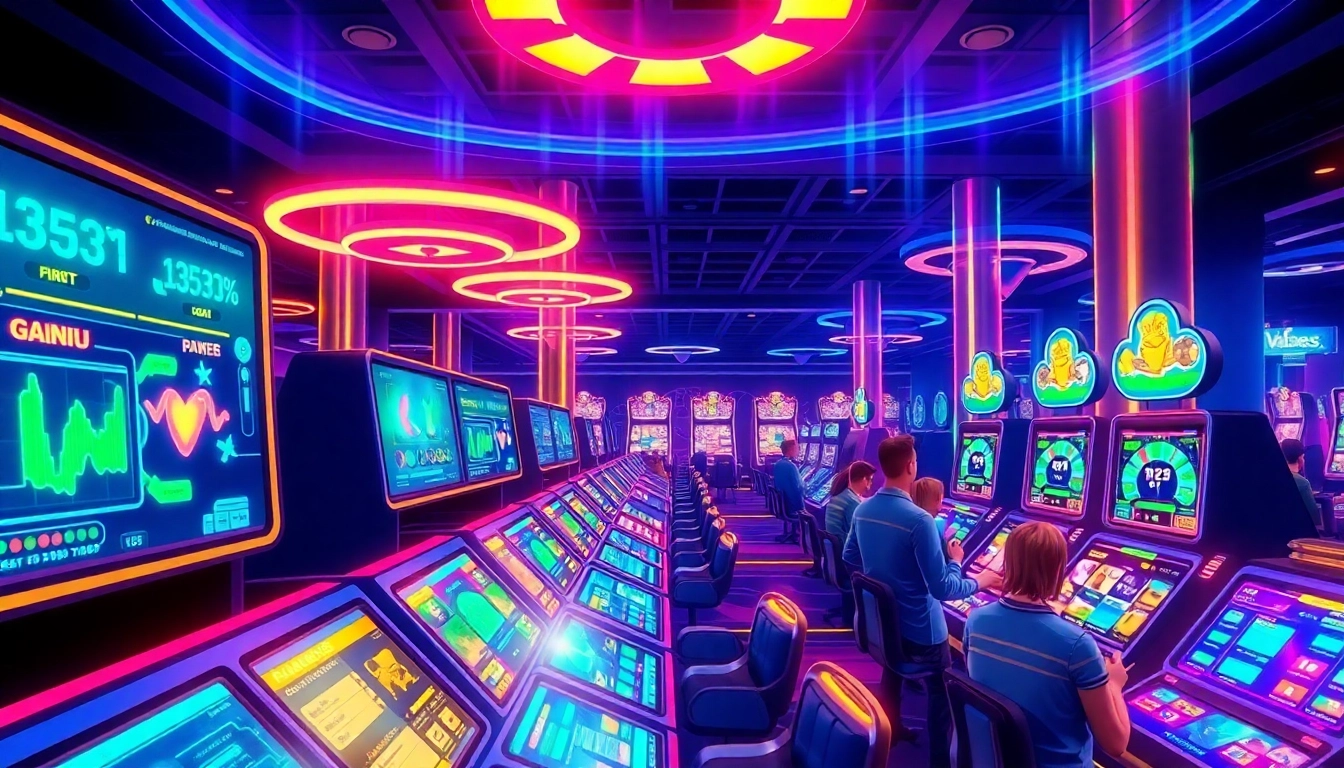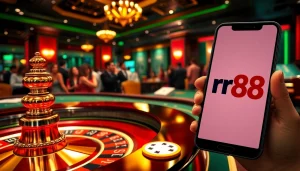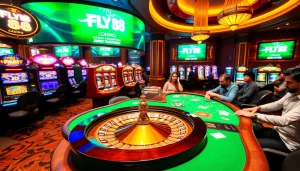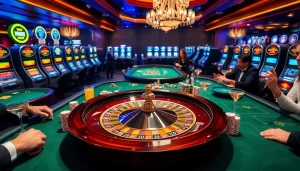Proven Gamification System: 5 Essential Benefits for Casinos

Understanding the Gamification System in Casinos
What is Gamification?
Gamification is the process of integrating game mechanics into non-game contexts to engage users and enhance their participation. In the context of casinos, gamification involves using elements typically found in games—such as points, badges, leaderboards, and challenges—to improve customer interaction, retention, and satisfaction. By strategically implementing a gamification system, casinos can create a more immersive experience that motivates players to continually participate in gaming activities, whether they are playing traditional table games or engaging with digital platforms.
Benefits of Gamification in Gaming
The benefits of gamification in gaming, particularly in casinos, are multi-faceted:
- Increased Player Engagement: By incorporating game-like elements, players feel a stronger connection to the activity, leading to longer play sessions and increased loyalty.
- Enhanced Customer Experience: A gamified approach provides a more personalized experience, allowing players to progress through levels or unlock rewards based on their preferences and playing styles.
- Data-Driven Insights: Gamification can track player behavior, which offers invaluable data to casinos for tailoring marketing strategies and improving game offerings.
- Encouragement of Competitive Spirit: Leaderboards and challenges foster a sense of community, pushing players to improve their skills and interact with others.
- Revenue Growth: Engaged players are more likely to spend money, experiment with new games, and participate in promotions, directly impacting the casino’s bottom line.
Key Features of a Successful Gamification System
A successful gamification system in casinos must incorporate essential features:
- Clear Objectives: Players should know what they need to achieve to earn rewards or progress within the system.
- Instant Gratification: Offering immediate rewards keeps players motivated and encourages ongoing participation.
- Challenges and Levels: Providing various levels of challenges caters to different player skills and keeps the experience fresh.
- Social Interaction: Including forums, chats, or team competitions can enhance the sense of community among players.
- Feedback Mechanisms: Regular feedback through game progress notifications or performance assessments helps players understand how they are doing.
Implementing a Gamification System
Steps for Effective Implementation
To effectively implement a gamification system, casinos should follow these steps:
- Define Goals: Identify what you want to achieve with your gamification system—whether it’s increasing time spent on games, enhancing customer loyalty, or improving the enjoyment of gaming experiences.
- Understand Your Audience: Analyze your target demographics to develop gamification elements that appeal to their motivations and preferences.
- Choose the Right Game Mechanics: Select elements that align with your objectives, such as points systems, levels, or reward structures that resonate with your audience.
- Integrate Technology: Utilize cutting-edge technology to create engaging experiences—this could mean mobile apps, web platforms, or in-casino kiosks.
- Test and Iterate: Begin with a pilot program, gather data, and refine your system based on feedback and engagement metrics.
Choosing the Right Tools
Selecting the appropriate tools is vital for a successful gamification strategy. Some tools to consider include:
- Player Management Systems: Software that tracks player behavior, preferences, and rewards to personalize experiences.
- Mobile Applications: Dedicated apps that incorporate gamified elements and enable players to engage from anywhere.
- Data Analytics Tools: These help assess and analyze player interactions, allowing casinos to fine-tune their offerings.
- Social Media Integration: Enabling players to share their achievements can promote community engagement and bring new players in.
- In-Casino Displays: Digital leaderboards and screens that showcase player progress can create excitement and friendly competition.
Common Challenges and Solutions
While implementing a gamification system can be rewarding, several challenges may arise:
- Resistance to Change: Some players might be hesitant to adapt to a new system. Overcome this by offering incentives for participation and demonstrating the value of the new features.
- Balancing Rewards: Excessive rewards can devalue the system, while too few can alienate players. Regular assessments and adjustments are key.
- Complexity: A poorly designed gamification system can overwhelm players. Simple and intuitive designs will enhance user experience.
- Measuring Effectiveness: Establishing clear KPIs from the start can help monitor the effectiveness of the system and make necessary improvements.
Enhancing Player Engagement through Gamification
The Role of Rewards and Incentives
Effective gamification hinges on the strategic use of rewards and incentives. Players are more likely to engage with systems that offer tangible benefits for their participation:
- Points Systems: Earning points for gameplay that can be redeemed for bonuses or prizes boosts player retention.
- Exclusive Rewards: Providing special promotions or rewards for high-performing players encourages competition and engagement.
- Tiered Incentives: Players can achieve various levels of rewards, inspiring them to strive for more significant achievements.
- Limited Time Offers: Urgency can spur action by offering players time-sensitive rewards or challenges.
Building Community and Competitiveness
Casinos can foster a sense of community through competitive elements. Features that encourage social interaction enhance the overall gaming experience:
- Leaderboards: Displaying player rankings injects competitiveness and motivates players to improve their performance.
- Team Competitions: Organizing group challenges allows players to collaborate, increasing camaraderie and player retention.
- Community Events: Hosting tournaments or themed nights can create buzz and bring players together.
- Social Features: Enabling players to share achievements on social media strengthens community ties and drives new traffic.
Real-world Examples of Success
Several casinos have successfully integrated gamification systems. Notable examples include:
- Las Vegas Sands: They implemented a points-based loyalty system that rewards players for various actions beyond just betting, enhancing customer retention.
- Caesars Entertainment: Their Total Rewards program gamifies the player experience by integrating tier levels that provide players with exclusive benefits.
- Hard Rock Casino: They leverage mobile applications to offer real-time rewards, promotions, and interactive challenges that increase player participation.
Measuring the Success of Your Gamification System
Key Performance Indicators (KPIs) to Monitor
To evaluate the effectiveness of your gamification system, focus on the following KPIs:
- Player Retention Rate: Tracking how many players return after their initial experience can signal the system’s success.
- Engagement Metrics: Monitor the duration of gameplay and the frequency of play to gauge interest levels.
- Revenue per User: Measuring the increase in spending habits among engaged players can determine financial effectiveness.
- Feedback Scores: Implement surveys to gather player opinions and suggestions that can guide further improvements.
Analyzing Player Feedback
Gathering and analyzing player feedback is crucial for enhancing the gamification system:
- Surveys and Polls: Regularly solicit player input on their experiences to identify areas for improvement.
- In-depth Interviews: Conduct interviews with a diverse group of players to gain qualitative insights into their motivations and preferences.
- Player Behavior Analytics: Use data tracking systems to analyze player interactions and behaviors for actionable insights.
Continuous Improvement Strategies
Maintaining the effectiveness of a gamification system requires ongoing refinement:
- Regularly Update Features: Keep the system fresh and engaging by cycles of updates based on player feedback and trends.
- Monitor Industry Trends: Stay current with new technologies, ideas, and strategies emerging in the gaming industry to keep the platform innovative.
- Test New Ideas: Continuously experiment with new game mechanics or features and gather feedback to determine their impact prior to full implementation.
The Future of Gamification in the Casino Industry
Emerging Technologies Enhancing Gamification
As technology continues to evolve, so will gamification systems in casinos:
- Artificial Intelligence: AI can personalize experiences for players by analyzing their habits and preferences.
- Virtual and Augmented Reality: Offering immersive gameplay through VR and AR technologies can revolutionize the gambling experience.
- Blockchain: This decentralized technology can increase transparency and trust within gaming environments, enhancing player confidence.
Trends to Watch in Player Engagement
The following trends can shape the future of gamification in casinos:
- Mobile Engagement: Increasing reliance on mobile platforms will necessitate gamified experiences tailored specifically for small screen interactions.
- Social Gamification: Integrating elements of social networks will become essential in creating community-driven gaming experiences.
- Personalization: Leveraging big data to offer customized experiences will be crucial in engaging players.
Challenges Ahead: Staying Ahead of the Curve
As with any evolving industry, casinos will face challenges in adapting to ongoing changes:
- Balancing Innovation with Tradition: While new technologies are important, keeping the core gaming experience intact is essential for maintaining player loyalty.
- Regulatory Compliance: Adapting to new laws and regulations regarding gaming can complicate the implementation of gamification systems.
- Handling Increased Competition: With continual advancements, casinos must innovate consistently to remain competitive in attracting players.






